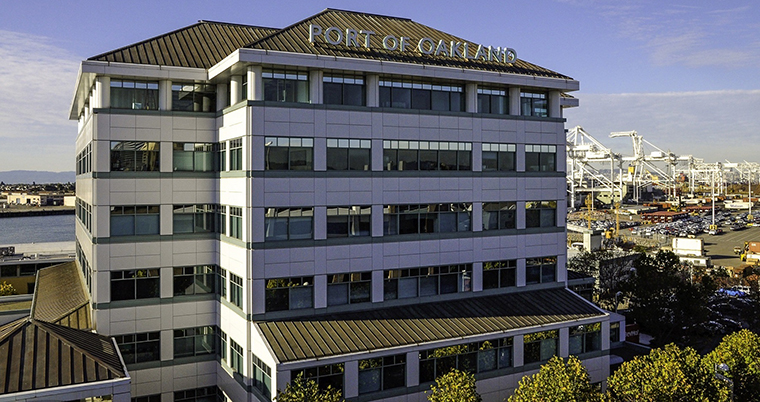The Port of Oakland's headquarters has received Energy Star certification for the 11th year in a row.

To be Energy Star certified, a building must rank among the top 25 percent of the most energy-efficient buildings in its market. The Port of Oaklandís headquarters ranked in the top 19 percent, and its energy efficiency is a key part of the portís sustainability program. Photo courtesy of Port of Oakland
BY BILL PICTURE
Published: May, 2017
The Port of Oakland’s headquarters has received Energy Star certification for the 11th year in a row. The five-story building located at 530 Water Street is also one of only 70 buildings in the state to be recognized as energy efficient by the United States Environmental Protection Agency (EPA).
On average, an Energy Star certified building uses about 35 percent less energy than a traditional building, and emits about 35 percent less greenhouse gas. “Environmental advocacy is an integral part of our Port of Oakland workforce culture. The Energy Star certification recognizes energy efficiency in port buildings as a key element of the port’s sustainability program,” said Richard Sinkoff, the port’s director of environmental programs and planning.
To be certified, a building must rank among the top 25 percent of the most energy-efficient buildings in its market. The Port of Oakland’s headquarters ranked in the top 19 percent. And Sinkoff said this is just the tip of iceberg in terms of the port’s green intentions. “It’s just one example of our efforts to promote sustainability throughout the agency,” he said.
Another example is the shore power infrastructure installed at the seaport. Completed a few years ago, this has resulted in a dramatic, 75-percent reduction in diesel emissions by allowing vessels to shut off their engines while docked and plug into the port‘s energy grid.
The port has also extended its operating hours. Staying open later has eased congestion and minimized idling time for trucks waiting to transport incoming cargo to its final destination. Truck-related emissions at the port are down 98 percent from 2005.
All of these figures are particularly impressive because cargo volume at the port has not decreased; in March, the volume of inbound cargo at the port was up 19 percent over the previous year.
Back at headquarters, among the steps taken recently to make the building more efficient was the addition of an equipment management system that allows for temperature-control and lighting equipment to be used as needed. “We shut as much off as we can during the evening and weekend hours,” Sinkoff said.
Motion sensors were also installed in restrooms so that lights turn off when not occupied, and the port is in the process of replacing traditional lighting with energy-efficient LED lighting. Office equipment has also been programmed to go into “sleep” mode when not in use for extended periods.
“All of these efforts combined have produced valuable energy savings, and reduced the overall energy footprint for this facility,” Sinkoff said.
Just the beginning
Sinkoff said the port is always on the lookout for new opportunities to green the agency and its facilities. The result has been an environmental to-do list to which new projects are continually being added.
“We look at opportunities for renewable energy sources, passive and active systems for energy efficiency and recycled, renewable and sustainable materials,” Sinkoff said, pointing to the recently approved 20-year solar energy purchase reported in last month’s Bay Crossings.
Also near the top of the to-do list are reducing water waste and increasing water recycling and groundwater recharging. To this end, Sinkoff said the port is currently reviewing landscape design and stormwater system options, as well as procuring water-saving fixtures for port headquarters.
“Other areas where we intend to continue reviewing options for reducing the port’s environmental footprint are alternative-fuel equipment and vehicles for operations,” he said. The port is also looking into providing bicycles for staff and guests to use on port property.
What stands most between the port and its dream of becoming a wholly sustainable agency and business enterprise is money. While state and federal subsidies help offset the cost of green upgrades, the port foots most of the bill for such projects. The funds come from operating revenues, and from a capital improvements budget.
And while green technology is moving at breakneck speed in terms of innovation, the commercial applications of these technologies are slow to be developed. “Many of the newer technologies are not yet commercially available,” Sinkoff said.
Furthermore, Sinkoff said that implementing these technologies at an agency with varied functions like the port—which in addition to overseeing the seaport also operates a busy airport and 20 miles of waterfront—is sometimes a challenge.
Still, the will to be greener is there and is showing real benefits. And Sinkoff said that much of the pressure to do better originates from within the agency itself. Port employees, it seems, are driving many of the operational changes, pushing to create a workplace that reflects their personal efforts to live greener lives off the clock.
“The Oakland Board of Port Commissioners approved a sustainability policy back in 2000,” Sinkoff said, “and it’s been a part of the port culture and way of thinking ever since.”

